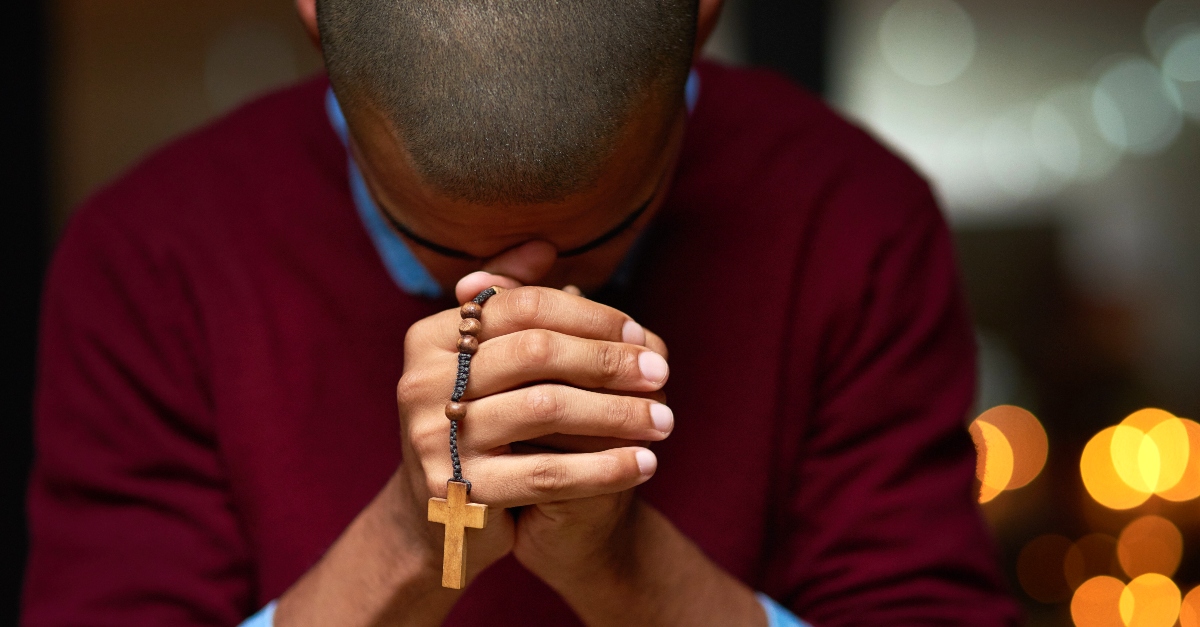Why Do Catholics Pray the Rosary and What Does it Mean?

Praying the rosary is traditionally associated with the Catholic Church, but Protestant Christians sometimes use rosary beads for meditative prayers to God rather than Mary. Discover what the rosary is, why Catholics pray it, and how praying the rosary in a biblical way can be a useful tool for meditating on the meaning and significance of your prayers.
What Does Praying the Rosary Mean?
Praying the rosary involves using a string of beads called a rosary as a tool for keeping track of prayers. People either hold or wear the rosary while they pray and touch an individual bead when they pray each individual prayer, moving their hands from one bead to the next to help them focus their minds on each prayer. As they do so, they meditate on the meaning and significance of each prayer.
The Catholic rosary consists of a series of 20 prayers and is typically prayed in a specific sequence, with each prayer being recited in turn. The sequence of prayers is divided into four groups of five, which are known as decades. Each decade is intended to represent one of the Mysteries of the Rosary, which are events from the lives of Jesus and the Virgin Mary. Those mysteries are divided into four categories: the Joyful Mysteries, the Sorrowful Mysteries, the Glorious Mysteries, and the Luminous Mysteries. Specific prayers include the Apostles’ Creed, the Our Father, the Hail Mary, the Glory Be, and the Hail Holy Queen.
The word “rosary” means “crown of roses” and derives from the idea of presenting a group of prayers to Mary like a spiritual bouquet of roses, in veneration for her role as Jesus’ earthly mother. While Catholics pray to Mary, Protestant Christians don’t since prayer can be a form of worship, and the Bible cautions us to worship God alone. Many of the traditional Catholic rosary prayers are directed to Mary, which presents a problem for Christians who are interested in the rosary but don’t want to direct their prayers to Mary. Fortunately, rosary prayers can be directed to God, rather than to Mary. It’s possible to simply use rosary beads to keep track of any type of prayer. You can use a rosary to pray any prayer from your heart to God, rather than reciting traditional rosary prayers.
Why Do Catholics Pray the Rosary?
The practice of praying the rosary has a long history in the Catholic Church. According to Catholic tradition, Mary described the rosary to Saint Dominic in the 13th century, during a miraculous apparition he said he saw in Toulouse, France. Prior to that time, Orthodox Christians had already been using another type of tool – ropes – to help them keep track of groups of prayers. They had an ancient practice of saying a prayer and then tying a knot in a rope afterward to remember where they were in a prayer sequence.
Today, rosary prayers are popular among Catholics. By reflecting on the Mysteries of the Rosary, Catholics are able to connect emotionally with the lives of Jesus and Mary. Catholics also see the rosary as a way to ask for Mary's intercession for them with God, as Catholics believe that she has a special role in bringing their prayers to God. Protestant Christians reject that idea since 1 Timothy 2:5-6 says that “For there is one God and one mediator between God and mankind, the man Christ Jesus, who gave himself as a ransom for all people…”. Protestant Christians pray with confidence directly to God (the Father, the Son, and the Holy Spirit) as Hebrews 4:16 encourages us to “… approach God’s throne of grace with confidence, so that we may receive mercy and find grace to help us in our time of need.”
Another reason that Catholics pray the rosary is for its meditative qualities. The repetition of the prayers and the movement of the beads can help to create a sense of calm and focus, allowing the person praying to experience a peaceful state of mind and enter into a deep state of prayer and meditation. Protestant Christians can experience those same benefits by using rosary beads while praying their own prayers.
In addition, Catholics often use the rosary as a form of communal prayer. Many Catholics pray the rosary together as a group, either in a church setting or in a more informal setting such as a family gathering. Praying the rosary as a group can create a sense of unity and shared purpose, as well as providing an opportunity for people to support one another in prayer. When people come together to pray the rosary, they are united in their shared experience of praying and meditating. This sense of unity and common purpose can be a powerful reminder of how faith can bring people together.

Photo Credit: ©iStock/Getty Images Plus/Peopleimages
Is Praying the Rosary Biblical?
The rosary is not mentioned in the Bible. However, many of the prayers and themes that are central to the traditional rosary are rooted in the Bible, and praying the rosary can be practiced in a biblical way by simply using the beads while praying to God and meditating on your prayers and Jesus’ life on earth.
The traditional rosary prayers relate to important biblical events, which you can reference to use in your own prayers to God. For example, the Hail Mary, which is one of the central prayers of the rosary, is based on the greeting of the angel Gabriel to Mary in Luke 1:28: “The angel went to her and said, ‘Greetings, you who are highly favored! The Lord is with you.’” Similarly, the Mysteries of the Rosary are all based on events from the lives of Jesus and Mary that are described in the Bible. The Joyful Mysteries, for instance, include the Annunciation (Luke 1:26-38), the Visitation (Luke 1:39-56), the Nativity (Matthew chapters 1 and 2, and Luke chapters 1 and 2), and the story of Jesus as a boy at the temple (Luke 2:41-52).
It’s also important to note that reciting traditional rosary prayers directed to Mary is not a biblical practice. Since prayer is often a form of worship, it’s best to direct your prayers only to God, who is the only One worthy of worship. Exodus 20:4-5 urges: “You shall not make for yourself an image in the form of anything in heaven above or on the earth beneath or in the waters below. You shall not bow down to them or worship them…”.
However, if you use a rosary simply to help you practice prayer and meditation with God, that’s biblical, since the Bible recommends contemplation. God tells us in Psalm 46:10: “… Be still, and know that I am God…” and meditative prayer can help us do so. Psalm 1:1-2 declares: “Blessed is the one who does not walk in step with the wicked or stand in the way that sinners take or sit in the company of mockers, but whose delight is in the law of the Lord, and who meditates on his law day and night.” In Psalm 119:15, King David writes: “I meditate on your precepts and consider your ways.” Joshua 1:8 urges: “Keep this Book of the Law always on your lips; meditate on it day and night, so that you may be careful to do everything written in it. Then you will be prosperous and successful.” In Philippians 4:8, we read an exhortation to meditate on positive thoughts: “Finally, brothers and sisters, whatever is true, whatever is noble, whatever is right, whatever is pure, whatever is lovely, whatever is admirable – if anything is excellent or praiseworthy – think about such things.”
Praying the rosary in a biblical way involves letting go of reciting traditional rosary prayers and instead praying prayers from your own heart to God, while using rosary beads to help you focus and meditate on what you’re praying. In my book Wake Up to Wonder, I describe how breaking free from prayer and meditation formulas can help us experience more of God’s awe-inspiring presence with us when we communicate with him. Praying and meditating honestly from our hearts, instead of following formulas, can help us experience the wonder of God reaching out to us from his heart.
Conclusion
While praying the rosary in the traditional way – reciting prayers to Mary – isn’t biblical, using rosary beads to pray from your heart to God can be a useful spiritual practice. A rosary can be a physical tool to help you focus your mind while praying and meditating on the meaning and significance of your prayers and on events from Jesus’ earthly life.
Photo Credit: ©iStock/Getty Images Plus/Mongkolchon Akesin

This article is part of our Prayer resource meant to inspire and encourage your prayer life when you face uncertain times. Visit our most popular prayers if you are wondering how to pray or what to pray. Remember, the Holy Spirit intercedes for us, and God knows your heart even if you can't find the words to pray.
The Lord’s Prayer
Prayer for Peace
Morning Prayers
Good Night Prayers
Prayer for Healing
Prayer for Protection
Prayer for Anxiety
Prayer for Strength
Now available is our new Daily Prayer devotional and podcast! An easy way to start your day with prayer: read or listen to today’s prayer and sign up to receive it by email.
Originally published April 17, 2023.






